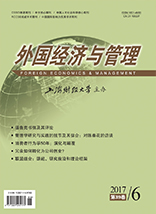如今,品牌国际化已是企业走进国际市场、树立全球性品牌的必经之道。对于跨国企业如何在国际市场中赢得竞争优势,学术界也展开了较多的研究。然而现有的研究大多聚焦于物质战略层面,而忽视了修辞战略对于品牌国际化的重要性,尤其对于新兴市场企业而言,通过有效的修辞沟通策略来削弱外国者劣势和减少东道国消费者的偏见已是迫在眉睫。因此,本文从社会建构视角出发,以社会运动理论为基础,以联想、三星、LG和星巴克为案例,运用多案例研究方法构建了品牌国际化沟通策略理论模型。该模型认为,跨国企业可以通过以下两个方面的努力来削弱外国者劣势:(1)构建一个好的品牌修辞沟通框架,具体包括详述策略、延伸策略和桥接策略;(2)通过引起消费者的框架联结的可信性共鸣、一致性共鸣以及通约性共鸣获取受众支持。本文拓展了跨国品牌沟通策略方面的研究,丰富了社会运动理论在营销领域的应用,并且为跨国企业尤其是新兴市场企业在跨国营销中的沟通策略制定提供了参考。
品牌国际化中如何实现有效的沟通——基于社会运动理论的多案例研究
摘要
参考文献
5 Benford R D, Snow D A. Framing processes and social movements: An overview and assessment[J]. Annual Review of Sociology, 2000, 26(1): 611–639. DOI:10.1146/annurev.soc.26.1.611
6 Chu P Y, Chang C C, Chen C Y, et al. Countering negative country-of-origin effects: The role of evaluation mode[J]. European Journal of Marketing, 2010, 44(7-8): 1055–1076.
7 Cordell V V. Effects of consumer preferences for foreign sourced products[J]. Journal of International Business Studies, 1992, 23(2): 251–269. DOI:10.1057/palgrave.jibs.8490267
8 Cornelissen J P, Holt R, Zundel M. The role of analogy and metaphor in the framing and legitimization of strategic change[J]. Organization Studies, 2011, 32(12): 1701–1716. DOI:10.1177/0170840611425729
9 Davis G F, McAdam D, Scott W R, et al. Social movements and organization theory[M]. Cambridge: Cambridge University Press, 2005.
10 Davis G F, Morrill C, Rao H, et al. Introduction: Social movements in organizations and markets[J]. Administrative Science Quarterly, 2008, 53(3): 389–394. DOI:10.2189/asqu.53.3.389
11 Eden L, Molot M A. Insiders, outsiders and host country bargains[J]. Journal of International Management, 2002, 8(4): 359–388. DOI:10.1016/S1075-4253(02)00095-9
12 Eisenhardt K M. Building theories from case study research[J]. Academy of Management Review, 1989, 14(4): 532–550.
13 Eisenhardt K M, Graebner M E. Theory building from cases: Opportunities and challenges[J]. Academy of Management Journal, 2007, 50(1): 25–32. DOI:10.5465/AMJ.2007.24160888
14 Gaertner S L, Mann J A, Dovidio J F, et al. How does cooperation reduce intergroup bias?[J]. Journal of Personality and Social Psychology, 1990, 59(4): 692–704. DOI:10.1037/0022-3514.59.4.692
15 Ghoshal S, Moran P. Bad for practice: A critique of the transaction cost theory[J]. Academy of Management Review, 1996, 21(1): 13–47.
16 Goffman E. Frame analysis: An essay on the organization of experience[M]. Cambridge, MA, US: Harvard University Press, 1974.
17 Hennart J F, Roehl T, Zeng M. Do exits proxy a liability of foreignness? The case of Japanese exits from the US[J]. Journal of International Management, 2002, 8(3): 241–264. DOI:10.1016/S1075-4253(02)00065-0
18 Heracleous L, Barrett M. Organizational change as discourse: Communicative actions and deep structures in the context of information technology implementation[J]. Academy of Management Journal, 2001, 44(4): 755–778. DOI:10.2307/3069414
19 Humphreys A. Megamarketing: The creation of markets as a social process[J]. Journal of Marketing, 2010, 74(2): 1–19. DOI:10.1509/jmkg.74.2.1
20 Kostova T, Zaheer S. Organizational legitimacy under conditions of complexity: The case of the multinational enterprise[J]. Academy of Management Review, 1999, 24(1): 64–81.
21 Lotz S L, Hu M Y. Diluting negative country of origin stereotypes: A social stereotype approach[J]. Journal of Marketing Management, 2001, 17(1-2): 105–135. DOI:10.1362/0267257012571465
22 Luo Y D, Mezias J M. Liabilities of foreignness: Concepts, constructs, and consequences[J]. Journal of International Management, 2002, 8(3): 217–221. DOI:10.1016/S1075-4253(02)00066-2
23 Martin B A S, Lee M S W, Lacey C. Countering negative country of origin effects using imagery processing[J]. Journal of Consumer Behaviour, 2011, 10(2): 80–92. DOI:10.1002/cb.v10.2
24 Mathews J A, Cho D S. Combinative capabilities and organizational learning in latecomer firms: The case of the Korean semiconductor industry[J]. Journal of World Business, 1999, 34(2): 139–156. DOI:10.1016/S1090-9516(99)00013-9
25 Maynard D W. Narratives and narrative structure in plea bargaining[J]. Law & Society Review, 1988, 22(3): 449–482.
26 McAdam D, McCarthy J D, Zald M N. Comparative perspectives on social movements: Political opportunities, mobilizing structures, and cultural framings[M]. Cambridge: Cambridge University Press, 1996.
27 McCarthy J D, Zald M N. Resource mobilization and social movements: A partial theory[J]. American Journal of Sociology, 1977, 82(6): 1212–1241. DOI:10.1086/226464
28 Miller S R, Parkhe A. Is there a liability of foreignness in global banking? An empirical test of banks’ X-efficiency[J]. Strategic Management Journal, 2002, 23(1): 55–75. DOI:10.1002/(ISSN)1097-0266
29 Monteith M J. Self-regulation of prejudiced responses: Implications for progress in prejudice-reduction efforts[J]. Journal of Personality and Social Psychology, 1993, 65(3): 469–485. DOI:10.1037/0022-3514.65.3.469
30 Morsing M, Schultz M. Corporate social responsibility communication: Stakeholder information, response and involvement strategies[J]. Business Ethics: A European Review, 2006, 15(4): 323–338. DOI:10.1111/beer.2006.15.issue-4
31 Pettigrew T F. Generalized intergroup contact effects on prejudice[J]. Personality and Social Psychology Bulletin, 1997, 23(2): 173–185. DOI:10.1177/0146167297232006
32 Scott W R, Meyer J W. The organization of societal sectors[A]. Meyer J W, Scott W R. Organizational environments: Ritual and rationality[C]. Beverly Hills: Sage, 1983.
33 Sewell W H Jr. A theory of structure: Duality, agency, and transformation[J]. American Journal of Sociology, 1992, 98(1): 1–29. DOI:10.1086/229967
34 Snow D A, Rochford E B Jr, Worden S K, et al. Frame alignment processes, micromobilization, and movement participation[J]. American Sociological Review, 1986, 51(4): 464–481. DOI:10.2307/2095581
35 Thompson C J. Interpreting consumers: A hermeneutical framework for deriving marketing insights from the texts of consumers’ consumption stories[J]. Journal of Marketing Research, 1997, 34(4): 438–455. DOI:10.2307/3151963
36 Vaara E, Monin P. A recursive perspective on discursive legitimation and organizational action in mergers and acquisitions[J]. Organization Science, 2010, 21(1): 3–22. DOI:10.1287/orsc.1080.0394
37 Vaara E, Tienari J, Laurila J. Pulp and paper fiction: On the discursive legitimation of global industrial restructuring[J]. Organization Studies, 2006, 27(6): 789–813. DOI:10.1177/0170840606061071
38 Zaheer S. The liability of foreignness, redux: A commentary[J]. Journal of International Management, 2002, 8(3): 351–358. DOI:10.1016/S1075-4253(02)00070-4
引用本文
汪涛, 王源富, 黄净. 品牌国际化中如何实现有效的沟通——基于社会运动理论的多案例研究[J]. 外国经济与管理, 2017, 39(6): 39–53.
导出参考文献,格式为:
上一篇:消费者行为学50年:演化与颠覆





 , 2
, 2 9706
9706  18888
18888

